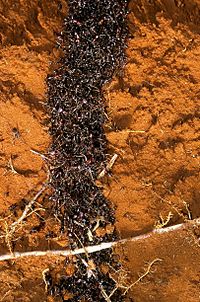
Back نمل الجيش Arabic Formiga guerrera AST Formiga legionària Catalan Wanderameisen German Εκστρατευτικό μυρμήγκι Greek Armeformiko Esperanto Hormiga guerrera Spanish مورچه ارتشی Persian Fourmi légionnaire French Seangán léigiúnach Irish
Parts of this article (those related to the previous dorylomorph subfamilies (Dorylinae, Aenictinae, Aenictogitoninae, Ecitoninae and Leptanilloidinae), all of which now are synonyms of Dorylinae) need to be updated. (September 2014) |

The name army ant (or legionary ant or marabunta[1]) is applied to over 200 ant species in different lineages. Because of their aggressive predatory foraging groups, known as "raids", a huge number of ants forage simultaneously over a limited area.[2]
Another shared feature is that, unlike most ant species, army ants do not construct permanent nests; an army ant colony moves almost incessantly over the time it exists. All species are members of the true ant family, Formicidae, but several groups have independently evolved the same basic behavioural and ecological syndrome. This syndrome is often referred to as "legionary behaviour", and may be an example of convergent evolution.[3][n 1]
Most New World army ants belong to the genera Cheliomyrmex, Neivamyrmex, Nomamyrmex, Labidus, and Eciton.[3] The largest genus is Neivamyrmex, which contains more than 120 species; the most predominant species is Eciton burchellii; its common name "army ant" is considered to be the archetype of the species. Most Old World army ants are divided between the tribes Aenictini and Dorylini. Aenictini contains more than 50 species of army ants in the single genus, Aenictus. However, the Dorylini contain the genus Dorylus, the most aggressive group of driver ants; 70 species are known.[citation needed]
Originally, some of the Old World and New World lineages of army ants were thought to have evolved independently, in an example of convergent evolution. In 2003, though, genetic analysis of various species suggests that several of these groups evolved from a single common ancestor, which lived approximately 100 million years ago at the time of the separation of the continents of Africa and South America, while other army ant lineages (Leptanillinae, plus members of Ponerinae, Amblyoponinae, and Myrmicinae) are still considered to represent independent evolutionary events.[3] Army ant taxonomy remains in flux, and genetic analysis will likely continue to provide more information about the relatedness of the various taxa.[4]
- ^ Dejean, Alain; Azémar, Frédéric; Roux, Olivier (2014-07-01). "An invasive ant species able to counterattack marabunta raids". Comptes Rendus Biologies. 337 (7): 474–479. doi:10.1016/j.crvi.2014.05.004. ISSN 1631-0691. PMID 25103833.
- ^ Cite error: The named reference
Schneirla, T. C. 1971was invoked but never defined (see the help page). - ^ a b c Cite error: The named reference
brady2003was invoked but never defined (see the help page). - ^ "Army Ants Harbor a Host-Specific Clade of Entomoplasmatales Bacteria". ResearchGate. Retrieved 2019-04-04.
Cite error: There are <ref group=n> tags on this page, but the references will not show without a {{reflist|group=n}} template (see the help page).
© MMXXIII Rich X Search. We shall prevail. All rights reserved. Rich X Search